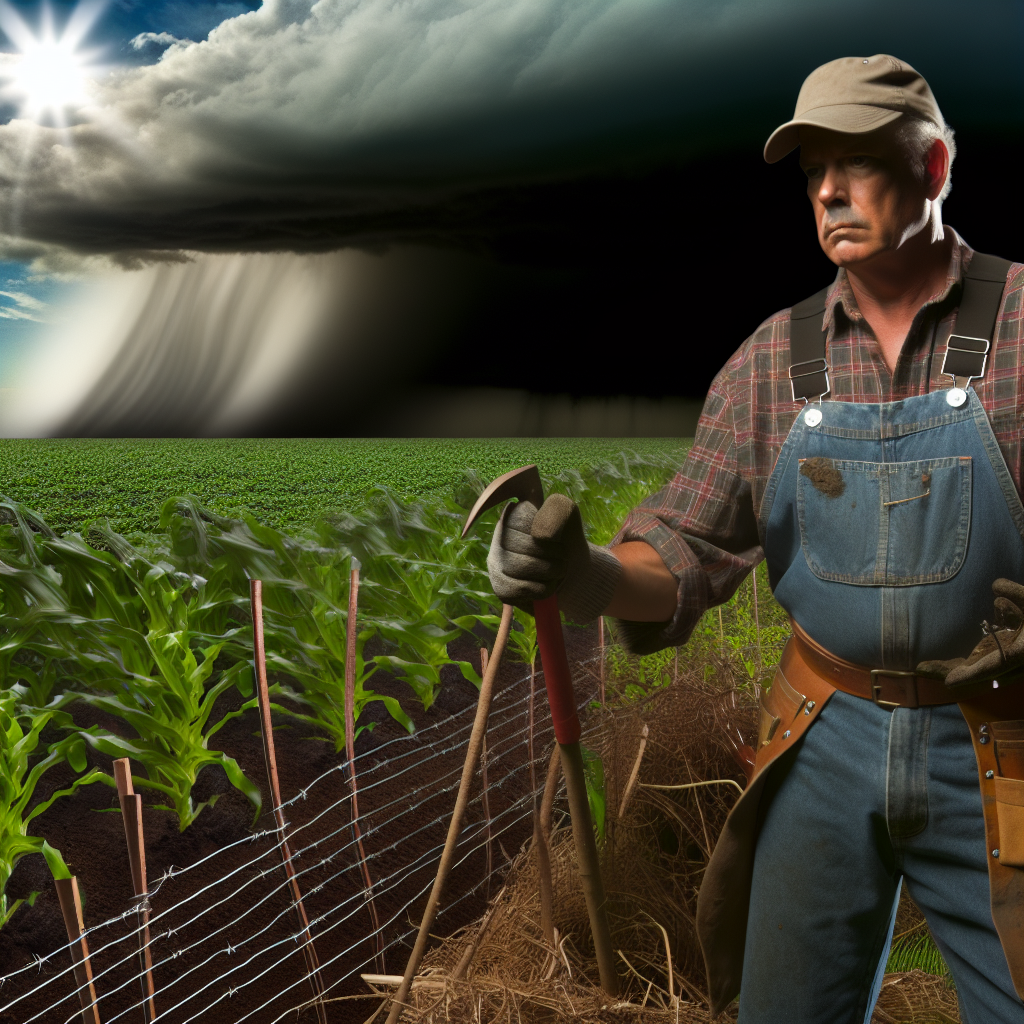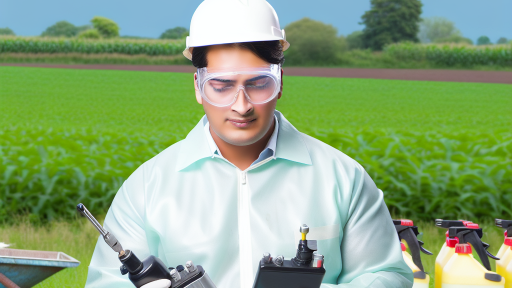Introduction to Agricultural Insurance and its Importance
Agricultural insurance plays a vital role in protecting farmers from unexpected losses.
This type of insurance safeguards their livelihood against natural disasters.
Natural events such as floods, droughts, and hurricanes can devastate crops.
Farmers depend on their harvests to sustain their families and communities.
Without insurance, a single disaster can lead to severe financial ruin.
Consequently, agricultural insurance provides peace of mind and financial security.
It encourages farmers to invest in better technologies and practices.
Moreover, this insurance supports food security on a broader scale.
When farmers are protected, they can focus on producing food efficiently.
Thus, agricultural insurance contributes to a stable economy.
It fosters resilience in the agricultural sector against climate change.
Farmers can recover more quickly from adverse weather impacts.
Ultimately, agricultural insurance is a key player in sustainable farming.
By mitigating risks, it enhances the viability of farming as a profession.
Therefore, understanding agricultural insurance is essential for all stakeholders.
Transform Your Agribusiness
Unlock your farm's potential with expert advice tailored to your needs. Get actionable steps that drive real results.
Get StartedThis understanding helps in making informed decisions about risk management.
Agricultural insurance is crucial for protecting food producers.
Overview of Natural Disasters Impacting Agriculture
Natural disasters pose significant threats to agriculture worldwide.
These events can devastate crops and disrupt food supply chains.
Farmers face challenges from various types of disasters.
Types of Natural Disasters
Hurricanes are among the most destructive storms.
They bring strong winds and heavy rainfall that can flood fields.
Additionally, tornadoes can damage infrastructure and crops rapidly.
Earthquakes can disrupt farmlands, making them unusable for production.
Moreover, wildfires pose a risk by destroying crops and soil health.
Droughts lead to water scarcity, drastically affecting yield.
Ultimately, each disaster type presents unique challenges for farmers.
Impact on Crop Production
Natural disasters significantly reduce crop yields.
Flooding can cause root rot, harming plant health.
High winds can break plants and uproot them entirely.
Even a few days of drought can stress crops severely.
Consequently, farmers may face financial losses after such events.
Economic Consequences
Severe weather events can lead to increased costs for farmers.
Restoring damaged infrastructure requires substantial investments.
Insurance claims may also take time to process.
Furthermore, natural disasters can cause market instability.
The ripple effects often touch consumers through rising food prices.
Thus, the entire agricultural economy feels the impact.
Types of Agricultural Insurance Coverage Available
Crop Insurance
Crop insurance protects farmers against losses due to natural disasters.
Showcase Your Farming Business
Publish your professional farming services profile on our blog for a one-time fee of $200 and reach a dedicated audience of farmers and agribusiness owners.
Publish Your ProfileThis type of insurance covers various risks, including droughts and floods.
Mainly, it includes yield protection and revenue protection options.
Farmers can choose policies based on their specific needs.
Moreover, crop insurance helps stabilize farmers’ income during tough times.
Livestock Insurance
Livestock insurance safeguards against the loss of livestock from disasters.
This coverage applies to various animals, such as cattle, poultry, and goats.
Farmers benefit from policies that cover theft, disease, and accidents.
Consequently, livestock insurance provides peace of mind to farmers.
Additionally, it ensures that farmers can recover faster after losing animals.
Farm Property Insurance
Farm property insurance covers physical assets on the farm.
This includes buildings, machinery, and equipment used in farming.
Insurance helps protect against losses from fire, vandalism, and severe weather.
Furthermore, it often covers additional living expenses during repairs.
This type of coverage is crucial for maintaining farm operations.
Natural Disaster Insurance
Natural disaster insurance provides coverage specifically for catastrophic events.
Farmers can secure protection against earthquakes, hurricanes, and wildfires.
This policy can be vital in regions prone to extreme environmental conditions.
It helps ensure that farms can rebuild and recover swiftly.
Thus, this type of insurance is essential for risk management.
Multi-Peril Crop Insurance
Multi-peril crop insurance offers comprehensive protection for crops.
This policy combines various risks into a single coverage option.
It covers everything from weather-related events to pest infestations.
This flexibility allows farmers to customize plans based on their operations.
Additionally, it enhances financial security against unpredictable challenges.
Uncover the Details: Maximizing Renewable Energy Incentives for Modern Farms
How Agricultural Insurance Mitigates Financial Losses
Understanding Agricultural Insurance
Agricultural insurance serves as a safety net for farmers.
This type of insurance protects against potential losses due to natural disasters.
Farmers can choose from various policies tailored to their specific needs.
Common types include crop insurance and livestock insurance.
Each policy aims to stabilize income during adverse conditions.
Types of Natural Disasters Covered
Agricultural insurance traditionally covers multiple natural disasters.
Floods can devastate crops and soil quality.
Hurricanes and storms also pose significant threats to farms.
Drought can severely limit crop yields, affecting revenue.
Insurance policies often include coverage for pest invasions as well.
Financial Stability Through Insurance
Insurance helps farmers maintain financial stability after disasters.
By compensating losses, it reduces the emotional and financial burden.
Farmers can reinvest in their operations quickly with insurance payouts.
This swift recovery aids in maintaining local economies and employment.
Government Support and Policies
Many countries offer subsidies for agricultural insurance.
Showcase Your Farming Business
Publish your professional farming services profile on our blog for a one-time fee of $200 and reach a dedicated audience of farmers and agribusiness owners.
Publish Your ProfileThese initiatives encourage farmers to obtain necessary coverage.
Government programs often enhance affordability for small farmers.
Additionally, education initiatives help farmers understand coverage options.
Preventive Measures and Risk Management
Insurance policies incentivize farmers to adopt preventive measures.
Many insurers provide resources for better risk management.
Farmers who invest in technology can minimize potential losses.
For example, crop monitoring can alert growers to issues early.
Efficient water management practices can mitigate drought impacts.
Success Stories in Agricultural Insurance
Numerous farmers have benefited from agricultural insurance schemes.
Maria Lopez, a corn farmer in Iowa, successfully recovered from a drought.
Her insurance payout allowed her to replant the following season.
Similarly, Tom Nguyen, a cattle rancher in Texas, regained his herd after a flood.
His quick recovery helped him sustain local employment opportunities.
You Might Also Like: Understanding Government Conservation Incentives For Farmers
Case Studies: Successful Use of Agricultural Insurance
Impact of Drought on Crop Yields
In 2022, a severe drought hit the Midwest region of the United States.
The Smith family farm experienced significant crop losses due to the extended dry spells.
However, they had invested in agricultural insurance prior to this disaster.
This decision turned out to be vital for their financial stability.
As a result, the insurance covered a substantial portion of their losses.
This allowed them to recover and plan for future seasons.
Hurricane Damage in Coastal Areas
Hurricane Maria devastated many farms in Puerto Rico in 2017.
The Gonzalez family faced extensive damage to their banana plantations.
Fortunately, they had comprehensive agricultural insurance in place.
This insurance provided crucial support during recovery efforts.
It helped them restore their operations in a timely manner.
Subsequently, they were able to resume production and recover their market share.
Frost Risk Mitigation
California’s vineyards frequently face the threat of late spring frost.
The Martinez Vineyard implemented frost insurance to mitigate this risk.
In 2021, they experienced an unexpected late frost.
The insurance payout received helped them cover losses from that year.
This support was essential for replanting and maintaining their production capacity.
Consequently, they have continued to thrive in the competitive wine market.
Flood Recovery Strategies
Flooding can devastate farmland, as seen in the Midwest flooding of 2019.
The Johnson Family Farm fell victim to record water levels affecting their crops.
Their insurance policy included provisions for flood-related damages.
Thanks to this coverage, they received financial relief quickly.
This allowed them to invest in restoration and future flood defenses.
Thus, they are better prepared for similar occurrences in the future.
Uncover the Details: Climate-Smart Agriculture Conservation Initiatives

Challenges Facing Farmers in Accessing Insurance
High Premium Costs
Farmers often face prohibitively high premiums for insurance coverage.
Showcase Your Farming Business
Publish your professional farming services profile on our blog for a one-time fee of $200 and reach a dedicated audience of farmers and agribusiness owners.
Publish Your ProfileThis financial burden can deter many from purchasing necessary policies.
Consequently, those who need protection the most may forgo insurance.
Furthermore, rising costs do not always correlate with improved coverage options.
Poor Awareness and Understanding
Many farmers lack knowledge about available insurance products.
This lack of awareness can lead to underinsurance or complete avoidance of coverage.
Insurance programs can be complex and difficult to understand.
Farmers often do not receive adequate guidance from insurance agents.
Access to Information
Accessing information about agricultural insurance can be challenging.
Remote locations may limit farmers’ ability to obtain necessary details.
Moreover, digital literacy varies widely among farming communities.
This disparity creates barriers to obtaining critical insurance information.
Government Regulations
Regulatory requirements can complicate the insurance application process.
Farmers often find compliance with these regulations time-consuming.
Additionally, changing laws can create uncertainty for policyholders.
This complexity may discourage farmers from pursuing insurance altogether.
Lack of Tailored Options
Simplistic insurance models do not always cater to diverse farming needs.
Many policies fail to account for the unique risks faced by different crops.
This lack of customization leaves some farmers unprotected against specific threats.
In contrast, tailored insurance options could better meet individual farmer requirements.
You Might Also Like: How Farmers Can Access Government Grants for Agricultural R&D Projects
The Role of Technology in Agricultural Insurance
Data Collection and Analysis
Technology enhances the collection and analysis of agricultural data.
Farmers can now use satellite imagery for monitoring crop health.
This data allows for timely interventions to mitigate losses.
Furthermore, precision agriculture tools help in resource management.
Real-Time Risk Assessment
Advanced algorithms assess risks associated with natural disasters.
Insurance companies utilize weather forecasts to predict events.
As a result, farmers receive alerts about impending threats.
This proactive approach minimizes damage through preparedness.
Claim Processing Efficiency
Technology streamlines the claim processing system.
Farmers submit claims via mobile applications for efficiency.
This immediate access speeds up the evaluation of damages.
The use of drones further assists in assessing field conditions.
Customized Insurance Products
With technological advancements, insurance can be tailored to needs.
Farmers can choose coverage based on specific crop risks.
This customization leads to better financial protection.
Moreover, farmers can adjust their policies over time based on data.
Enhanced Customer Support
Insurance companies leverage chatbots for instant assistance.
This service offers 24/7 support for policy-related inquiries.
Additionally, agents can provide personalized advice based on data.
Ultimately, this increases customer satisfaction and trust.
Showcase Your Farming Business
Publish your professional farming services profile on our blog for a one-time fee of $200 and reach a dedicated audience of farmers and agribusiness owners.
Publish Your ProfileFuture Trends in Agricultural Insurance and Disaster Preparedness
Emerging Technology in Agricultural Insurance
Technology is revolutionizing the agricultural insurance landscape.
Insurers utilize AI to assess risks more accurately.
This technology enhances pricing strategies for farmers.
Moreover, drones provide real-time data on crop health.
This data aids in timely decision-making during disasters.
Shifting Climate Patterns and Their Impact
Climate change is altering natural disaster patterns.
Farmers face increasing risks from extreme weather events.
Agricultural insurance must adapt to these changes.
Insurers examine historical weather data to predict future risks.
They offer tailored policies for specific climate challenges.
Increased Collaboration Among Stakeholders
Collaboration is crucial for improving disaster preparedness.
Farmers, insurers, and government play critical roles together.
Sharing data and insights enhances collective responses.
This partnership supports efficient resource allocation during crises.
Furthermore, it promotes education on risk management strategies.
Policy Innovations for Enhanced Coverage
Insurers are developing innovative policies to address new realities.
These policies focus on comprehensive disaster protection.
Microinsurance products cater to smallholder farmers’ needs.
This approach ensures affordability and accessibility.
Overall, flexible coverage options are gaining traction.
Sustainable Practices and Insurance Solutions
Sustainability is a growing concern in agriculture.
Insurance solutions now incorporate sustainable practices.
Farmers receive incentives for adopting eco-friendly techniques.
This reduces overall risks and enhances productivity.
Consequently, sustainable agriculture aligns with risk mitigation.




